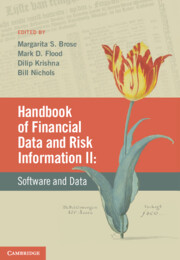Book contents
- Frontmatter
- Contents
- List of contributors
- Preface
- VOLUME II: SOFTWARE AND DATA
- PART IV DATA OPERATIONS IN FINANCIAL INSTITUTIONS
- PART V DATA MANAGEMENT TECHNOLOGIES
- 19 Financial data interchange standards
- 20 Data storage and processing
- 21 The extracting, transforming and transmitting of data
- 22 The visual analysis of financial data
- 23 Metadata management
- 24 Data security and privacy
- PART VI IMPLEMENTATION OF DATA AND ANALYTICS PROGRAMS
- Index – Volume II
- References
19 - Financial data interchange standards
from PART V - DATA MANAGEMENT TECHNOLOGIES
- Frontmatter
- Contents
- List of contributors
- Preface
- VOLUME II: SOFTWARE AND DATA
- PART IV DATA OPERATIONS IN FINANCIAL INSTITUTIONS
- PART V DATA MANAGEMENT TECHNOLOGIES
- 19 Financial data interchange standards
- 20 Data storage and processing
- 21 The extracting, transforming and transmitting of data
- 22 The visual analysis of financial data
- 23 Metadata management
- 24 Data security and privacy
- PART VI IMPLEMENTATION OF DATA AND ANALYTICS PROGRAMS
- Index – Volume II
- References
Summary
Introduction
Standards make modern commerce possible. In fact, modern commerce is wholly dependent upon a multitude of standards. It is not unreasonable to see the function of commerce and finance as an exercise in the creation of standard definitions for valuation and subsequent exchange of value Ferguson, 2008, p. 7). The dependency on and the necessity of standards is likely not fully understood by most people. We all see glimpses of these issues when consumers are confronted with vendors vying to become a de facto consumer standard, such as the recent competition between Blu-Ray and High Definition technology, or the oft used example of VHS versus Beta as the videotape standard in the 1970s.
This chapter will focus on the relevant current and emerging standards that the risk management practitioner should be aware of with respect to the production, dissemination, and aggregation of financial information. We will also provide an overview of the environment of standards and a framework for standards selection and usage. This framework is being provided as a form of risk mitigation in and of itself, as there is an inherent risk in every standards adoption decision.
Context for standards in finance
The expansion and sophistication of modern finance has followed the trajectory of, among others, three primary concurrent trends:
relaxation of laws governing finance in response to ascendant political philosophies stressing deregulation and “efficient market” economic theories coupled with the massive globalization of commerce and resultant extraterritoriality and corresponding opportunities for regulatory arbitrage by financial firms;
the application of advanced mathematics to finance, especially in the area of options pricing theory; and
the information technology and telecommunications revolution.
- Type
- Chapter
- Information
- Handbook of Financial Data and Risk Information IISoftware and Data, pp. 138 - 218Publisher: Cambridge University PressPrint publication year: 2014



